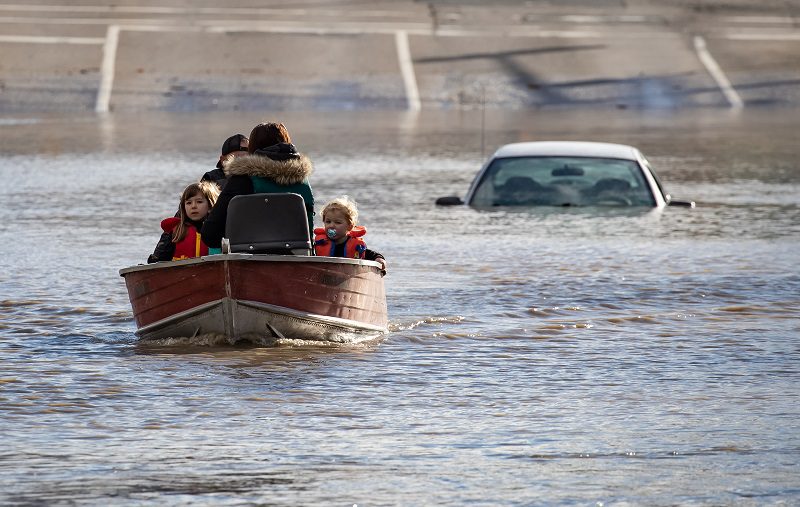Federal disaster aid program being overhauled to include climate adaptation

OTTAWA – Canada’s overworked disaster assistance program is being overhauled so that future projects would only be eligible for aid if they take into account the need to adapt to climate change.
Emergency Preparedness Minister Bill Blair, who was in British Columbia this week with the second instalment of disaster aid for the B.C. 2021 floods, said the government can’t keep sending out billions of dollars to help rebuild after a disaster without trying to prevent the same damage from happening the next time.
“I want those recovery funds tied to new building codes and new planning around how we can build back more resilient communities,” Blair said in an interview with The Canadian Press.
“Just building it back where it was and how it was prior to these events, when we know that they are occurring with greater frequency and severity, it wouldn’t do much (good) to continue to pay this money out.”
Blair launched a review of the disaster assistance program last year, and the review panel he appointed submitted its report and recommendations to him in the fall.
He said he was meeting with the panel chair in B.C. on Friday to talk about it, and will present the plan to provincial and territorial emergency preparedness ministers when he meets with them in the spring.
Tying disaster aid to climate adaptation is also part of the national adaptation strategy that was finalized last fall.
The Disaster Financial Assistance Arrangements program, known as DFAA, launched in 1970 to help pay for recovery efforts following natural disasters when the cost exceeds what a province or territory can reasonably afford.
iStock.com/doble-d
Eligible expenses can be costs associated with the event itself, such as emergency evacuations, as well as repairing damage to public infrastructure or systems, including roads, bridges and water treatment plants. Rebuilding and replacing belongings for primary homes and private businesses can qualify as long as they aren’t eligible for private insurance.
Provinces have to apply for help within six months but the costs can be submitted for up to five years. Each province has a population-based deductible before the program kicks in. In Prince Edward Island, DFAA kicks in when the costs hit $561,000, while in Ontario it doesn’t take effect until they top more than $50 million.
Ottawa then pays for up to 90 per cent of the remaining costs based on a specific formula.
But Blair said climate change means the disasters are piling up and the program’s costs are soaring. He said during the first 50 years of the program, Ottawa paid out $7 billion in aid to the provinces and territories.
Almost two-thirds of that was paid between 2013 and 2020.
He said he expects the program to hit that same total again to cover just the last two years of damages. That includes the deadly wildfires in B.C. in the summer of 2021 and widespread flooding that ravaged large swaths of the Lower Mainland and Okanagan Valley several months later.
Together those two events alone are expected to exceed $5 billion in recovery costs.
Blair said at least another $1 billion is expected to help the Atlantic provinces recover from post-tropical storm Fiona last fall.
The program is also approved or expected for other events in 2021 and 2022, including flooding in Manitoba and Northwest Territories, forest fires in Saskatchewan, a November rain and wind storm in Nova Scotia and hurricane Larry that walloped Newfoundland and Labrador.
A background document prepared by Public Safety Canada in 2020 said the standard budget for DFAA is $100 million a year, but it noted that’s no longer enough.
“In recent years, $100M has been typically insufficient to cover requests for federal funding,” the document said.
In fact, the last time it was sufficient was 2012, when the final budget was $99.97 million. It has gone over budget every year since, averaging $405 million a year for the last decade.
Still, the program’s budget allocation remains $100 million to start, including in the current year.
Blair said rebuilding better, more resilient communities will save money in the future, but he said it’s not just about the cost. It’s also about protecting people and their communities.
In Lytton, B.C., where a wildfire destroyed almost the entire town in June 2021, rebuilding is still on hold and awaiting a final remediation plan. Blair said the federal government is committed to help with the recovery costs, but the rebuilt community isn’t going to be the same as the old one.
“We want to rebuild that community in a way that’s fire smart and it’s going to be more resilient to this type of natural event,” he said.
That means, he said, smarter, fire-aware building codes, using fire-retardant materials, and designing structures to reduce their vulnerability to fires.
Feature image: A woman and children who were stranded by high water due to flooding are rescued by a volunteer operating a boat in Abbotsford, B.C., on Tuesday, November 16, 2021. THE CANADIAN PRESS/Darryl Dyck



